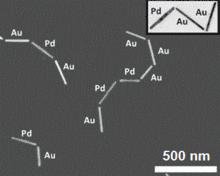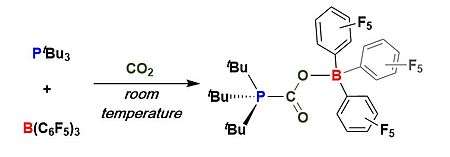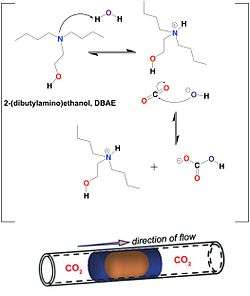Eugenia Kumacheva
Eugenia Kumacheva FRS FRSC[2] is a Professor of Chemistry at the University of Toronto and a Canada Research Chair in Advanced Functional Materials.[3][1] Her research interests span across the fields of fundamental and applied polymers science, nanotechnology, microfluidics, and interface chemistry. She was awarded the L'Oréal-UNESCO Awards for Women in Science in 2008 "for the design and development of new materials with many applications including targeted drug delivery for cancer treatments and materials for high density optical data storage".[4][5][6][2][7] In 2011, she published a book titled "Microfluidic Reactors for Polymer Particles "[8] co-authored with Piotr Garstecki. She is currently a tier 1 Canadian researcher in Advanced Polymer Materials and also a Fellow of Royal Society of Canada and Royal Society (UK).
Eugenia Kumacheva | |
|---|---|
 Eugenia Kumacheva at the Royal Society admissions day in London in 2016 | |
| Born | Odessa, Soviet Union |
| Nationality | Russian-Canadian |
| Alma mater | Saint Petersburg State Institute of Technology (BSc, MSc) Russian Academy of Science (PhD) |
| Awards | L'Oréal-UNESCO For Women in Science Award (2008) Canada Research Chair |
| Scientific career | |
| Fields | Chemistry Materials science Polymers Microfluidics Nanoscience[1] |
| Institutions | University of Toronto Weizmann Institute of Science Moscow State University |
| Website | www |
Education and early life
Eugenia Kumacheva was born in Odessa, Soviet Union. After earning her undergraduate degree (Cum Laude) from the Technical University in St. Petersburg,[9] she worked in industry for several years before beginning her Ph.D. research. In 1986, she obtained her Ph.D. degree in physical chemistry of polymers in the Russian Academy of Sciences .[9]
Career and research
Eugenia then worked as a staff scientist at the Moscow State University [10] before beginning her postdoctoral fellowship supported by Minerva Foundation with Professor Jacob Klein at the Weizmann Institute of Science in Israel.[10] She then joined the research lab of Professor Mitch Winnik at the University of Toronto in Canada to study multicomponent polymer systems. In 1996, Kumacheva became an Assistant Professor at the University of Toronto Chemistry Department, and in 2005, she was promoted to the ranks of Full Professor.[10] During her career, Kumacheva has delivered numerous invited, plenary and public lectures, and has been recognized by a large number of national and international awards. In 2008, she was the first Canadian recipient of the L'Oréal-UNESCO "Women in Science" Prize.[11] In 2016, she was elected a Fellow of the Royal Society.[2] In 2017, she was awarded a CIC medal "presented as a mark of distinction and recognition to a person who has made an outstanding contribution to the science of chemistry or chemical engineering in Canada, this is the CIC’s top award." Her book titled Microfluid reactor for Polymer Particles was published in 2011, and describes about the use of liquid flow through microscopic channels as a method of polymerization.[8]

Kumacheva's work focuses on polymer science, nanoscience, microfluidics, and interface chemistry. She has a strong effort in biomimetic research focused biological tissues, fluids, and environments with polymers and nanomaterials. Kumacheva has been involved with important developments in modeling the biological conditions of myocardial infarctions, strokes, pulmonary embolism, and various other blood related disorders or health conditions using polymers and nano-materials. Some of this work is related to mimicking blood vessels in order to gain a greater understanding of the chemistry and physics involved in blood clots. Kumacheva has been involved in research exploring the potential of microbubbles, a gas enclosed by a natural or synthetic polymer for both diagnostic and therapeutic applications such as targeted drug delivery and molecular imaging. An additional medical application of Kumacheva's work is the creation of hydrogels [13] and various other chemical environments to either support the life of a stem cell, affect necrotic heart tissue as well as deter the metastasis of cancer cells. Kumacheva has been involved in research involving cellulose nanocrystals (CNCs) and fluorescent latex nanoparticles (NPs[14]), as well as self-assembling nanocubes.
Quantifying the efficiency of CO₂ capture


Much of her work relates to climate change and lowering CO₂ levels. She has collaborated with Doug Stephan (University of Toronto), to investigate the behavior of frustrated Lewis pairs used to separate various elements of natural gas; namely, ethylene from a mixture of ethylene and methane. This work has great industrial importance due to the need for efficient and precise separation of petroleum compounds in various industries.[15]
Study of Extraction
In another study involving frustrated Lewis pairs, Kumacheva used them to quantify the efficiency of binding CO₂ emissions. Measuring the amount of CO₂ bound by the Lewis pairs provided information on the amount that was captured into solution. Some of the reactions in CO₂ uptake require solvents with different properties, but it is expensive to prepare multiple solvents. As a solution to this problem, Kumacheva has worked on solvents with adjustable properties such as hydrophilicity called switchable hydrophilicity solvents (SHS). For example, a sterically hindered, large, hydrophobic molecule (Dibutylethanol Amine – DBAE) being protonated to become hydrophilic as necessitated by the reaction process.[16]
Honors and awards
Kumacheva's awards and honors include:
- 1992: Minerva Foundation Fellowship (Germany)
- 1994: Imperial College London Visiting Fellowship (UK)
- 1999: Premier Research Excellence Award (Canada)
- 2000: International Chorafas Foundation Award
- 2002: Recipient of Canada Research Chair in Advanced Polymer Materials/Tier 2
- 2003: Schlumberger Scholarship University of Oxford
- 2004: Clara Benson Award (CIC Award)
- 2005: Macromolecular Science and Engineer Award, Chemical Institute of Canada
- 2006: Recipient of Canada Research Chair in Advanced Polymer Materials/ Tier 1
- 2007: Elected a Fellow of the Royal Society of Canada (FRSC)
- 2017: E. Gordon Young Lectureship, The Chemical Institute of Canada
- 2008: L'Oréal-UNESCO Women in Science Prize (Laureate for North America[11])
- 2009: Japan-Canada WISET lectureship, Royal Society of Canada
- 2010: Killam Research Fellowship, Canada Council for the Arts
- 2011: Distinguished Lecturer, The University of Western Ontario, Canada.
- 2011: Connaught Innovation Award, Connaught Foundation.
- 2012: Humboldt Research Award, Alexander von Humboldt Foundation (Germany).
- 2012: Inventor of the Year, University of Toronto
- 2013: University Professor (distinction given to <2% of Faculty at the University of Toronto
- 2016: Elected a Fellow of the Royal Society (FRS)[2] the British National Academy of Science
- 2017: Schmidt Lectureship, Weizmann Institute of Science, Israel
- 2017: Chemical Institute of Canada Medal
- 2019: 3M Lectureship
- 2019: De Gennes Prize, Royal Society of Chemistry
References
- Eugenia Kumacheva publications indexed by Google Scholar

- Anon (2014). "Eugenia Kumacheva". royalsociety.org. London: Royal Society. Archived from the original on 2018-09-09. Retrieved 2017-06-05. One or more of the preceding sentences incorporates text from the royalsociety.org website where:
"All text published under the heading 'Biography' on Fellow profile pages is available under Creative Commons Attribution 4.0 International License." --Royal Society Terms, conditions and policies at the Wayback Machine (archived 2016-11-11)
- Eugenia Kumacheva publications indexed by the Scopus bibliographic database. (subscription required)
- "2009 Edition Of The L'Oréal-Unesco For Women In Science Awards". L'Oréal Paris. 10 November 2008. Archived from the original on 16 November 2015. Retrieved 20 November 2015.
- "What Toronto's top minds are reading this summer". Megan Ogilvie. Toronto Star. 8 August 2010. Retrieved 20 November 2015.
- "New insights into 'switchable water' have implications for water purification and desalination". Lisa Zyga. phys.org. 10 August 2014. Retrieved 20 November 2015.
- Wong, Patrick. "Research". www.chem.utoronto.ca. Retrieved 2017-06-05.
- Kumacheva, Eugenia; Garstecki, Piotr (2011). Microfluidic Reactors for Polymer Particles - Kumacheva - Wiley Online Library. doi:10.1002/9780470979228. ISBN 9780470979228.
- "Professor Eugenia Kumacheva". University of Toronto.
- "Staff: Eugenia Kumacheva". University of Toronto.
- "2009 Edition Of The L'Oréal-Unesco For Women In Science Awards - L'Oréal Group". loreal.com. Retrieved 2017-05-12.
- Liu, Kun; Lukach, Ariella; Sugikawa, Kouta; Chung, Siyon; Vickery, Jemma; Therien-Aubin, Heloise; Yang, Bai; Rubinstein, Michael; Kumacheva, Eugenia (2014-03-03). "Copolymerization of Metal Nanoparticles: A Route to Colloidal Plasmonic Copolymers". Angewandte Chemie International Edition. 53 (10): 2648–2653. doi:10.1002/anie.201309718. ISSN 1521-3773. PMC 4000723. PMID 24520012.
- Wang, Yihe; Li, Yunfeng; Thérien-Aubin, Héloïse; Ma, Jennifer; Zandstra, Peter W.; Kumacheva, Eugenia (2016-01-01). "Two-dimensional arrays of cell-laden polymer hydrogel modules". Biomicrofluidics. 10 (1): 014110. doi:10.1063/1.4940430. PMC 4723409. PMID 26858822.
- Querejeta-Fernández, Ana; Kopera, Bernd; Prado, Karen S.; Klinkova, Anna; Methot, Myriam; Chauve, Grégory; Bouchard, Jean; Helmy, Amr S.; Kumacheva, Eugenia (2015-10-27). "Circular Dichroism of Chiral Nematic Films of Cellulose Nanocrystals Loaded with Plasmonic Nanoparticles". ACS Nano. 9 (10): 10377–10385. doi:10.1021/acsnano.5b04552. ISSN 1936-0851. PMID 26336902.
- Chi, Jay J.; Johnstone, Timothy C.; Voicu, Dan; Mehlmann, Paul; Dielmann, Fabian; Kumacheva, Eugenia; Stephan, Douglas W. (2017-03-28). "Quantifying the efficiency of CO₂ capture by Lewis pairs". Chemical Science. 8 (4): 3270–3275. doi:10.1039/C6SC05607E. ISSN 2041-6539. PMC 5424443. PMID 28553530.
- Lestari, Gabriella; Alizadehgiashi, Moien; Abolhasani, Milad; Kumacheva, Eugenia (2017-05-01). "Study of Extraction and Recycling of Switchable Hydrophilicity Solvents in an Oscillatory Microfluidic Platform". ACS Sustainable Chemistry & Engineering. 5 (5): 4304–4310. doi:10.1021/acssuschemeng.7b00339.
![]()